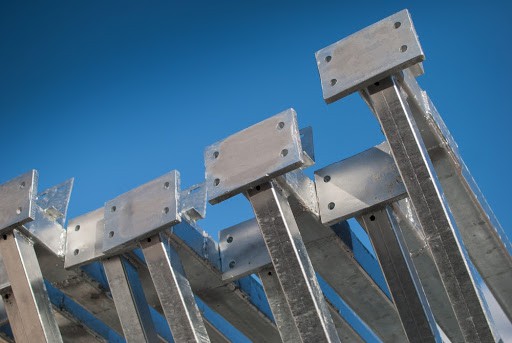Hot dip galvanized (HDG) steel goes through a special process that gives it the absolute best protection available against corrosive agents in the environment and extremes of temperature. The same way HDG steel doesn’t corrode when it’s exposed to rain and snow, it also stands up well in extreme heat and extreme cold.
That’s because the process of galvanizing steel doesn’t just coat it with a layer of zinc. It also forms a layer of an alloy of iron and zinc just below the zinc coating that provides the steel beneath it with still more galvanic protection. Even if something were to melt or abrade the top zinc layer away, this layer protects steel from corrosion, too. But, exactly what are the high and low temperature extremes for keeping galvanized steel in good condition?
HDG Steel in Extreme Heat
Experts agree that the maximum ambient temperature for maintaining structural integrity of HDG steel is 392° F, or 200°.C. If HDG steel is heated to temperatures above 392°.F, its outer layer of zinc begins to peel off.
The reason for this is that zinc and steel expand at different rates. Iron has a thermal expansion coefficient of 7.5. That means that it expands by 7.5 millionths of its original volume for every 1° F increase in the surrounding temperature.
Zinc has a thermal expansion coefficient of 19. That means it expands by 19 millionths of its volume for every 1° F increase in the surrounding temperature.
By the time HDG steel has been heated from, say, room temperature of 72° F to the kinds of temperatures you might encounter in a furnace room, 392° F, the steel core has expanded about 0.25 percent and the zinc on top of it has expanded about 0.6 percent. That’s not a big difference, but it’s enough to cause the formation of a gap between the zinc coating and the zinc-iron alloy layer of the steel so the zinc layer begins to peel.
The gap forms because thin layers of metal that’s expanding faster than thick layers of metal. If the HDG member or part is exposed to heat one one side and not the other, gaps will be more prominent. The more pieces there are in the assembly, the more the zinc will peel, too.
Of course, there is a similar effect while the HDG steel part or assembly member was first galvanized. Your galvanizing facility has to take differential thermal expansion coefficients into account to avoid warping the steel at the galvanizing plant. The same attention to time and temperature of heating at the galvanizing plant and care for the thickness of the coating can reduce the risk of peeling when the steel is exposed to fire. And adding as little as 0.0001 percent lead to the hot zinc dip reduces peeling at high heat, too.
Sometimes exposure to fire will degrade HDG steel and may require re-galvanizing. But the steel is protected by the layer of iron and zinc alloy up to temperatures of about 480° F (250° C). That’s the point at which serviceability becomes an issue. If you anticipate your HDG steel will be exposed to extreme heat in an industrial process on a predictable and regular basis, you should double check with your engineers and make sure your HDG plant knows the specs you need.
HDG Steel in Extreme Cold
Temperatures of -40° F (-40° C) don’t have an effect on the time to first maintenance for HDG steel, or at least we haven’t seen this effect yet. HDG steel has been in use in structures at the poles at these temperatures for over 20 years without any maintenance problems. Really extreme cold, in the -100° range, would make steel brittle with long-time use.
Do You Have Galvanizing Needs?
We are ready to provide everything you need for galvanized steel. Our central location allows us to serve the entire United States as the premier provider of hot dip galvanizing services. If you are in need of a galvanizing plant in your area, contact us to see how we can help.

